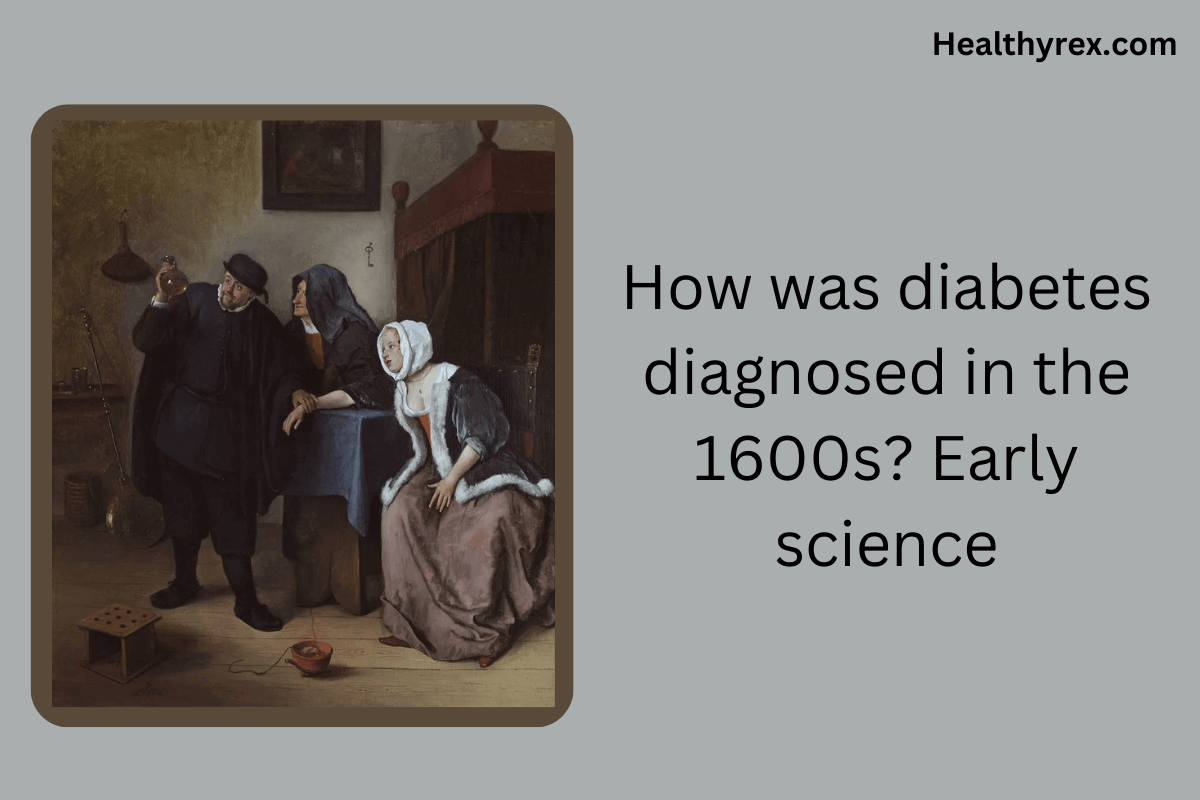How was diabetes diagnosed in the 1600s? Early science

Physicians and scientists have documented the condition currently known as diabetes for thousands of years. From the origin to the discovery of the treatments, many brilliant minds have played vital roles in the fascination of diabetes.
Diabetes beginning: The first mention of diabetes symptoms was in 1552 B.C. when the Egyptian scientist Hey-Ra documented the sign of a mysterious disease that included frequent urination that resulted in weight loss. Also, around this time, the ancient healers noted that the ants were more attracted to the urine of people with this mysterious disease.
In 150 AD, a Greek physician Aratus describes diabetes as the melting down of the limbs and flesh into the urine. From that point, the physicians gain a better understanding of diabetes disease.
In the later centuries, the water taster people diagnosed diabetes by tasting the suspected diabetic urine. The sweet taste in the urine diagnoses diabetes. To acknowledge this feature, in 1675, the word “Mellitus,” which means “honey,” was added with the name diabetes, which means siphon. It was in 1800 that scientists developed the chemical test to detect sugar in the urine.
Diabetes: Early treatment
The early Greek physician recommends treating diabetes with increased physical activity and, if possible, horseback. They believe that increased physical activity will reduce the need for excessive urination.
Some other treatment options include:
- Easy-to-digest food like mutton and veal
- Tobacco
- Narcotics like opium
- Fenugreek, wormseed, and lupin powders
- Rancid animal food
- Carb free diet
- Green vegetables
- A nonirritating milk and carb diet, for example, having rice with milk and starchy gummy foods, provides essential salts and thickens the blood: milk and barely boiled water with salt.
At that time, the doctor recommends having 65% fat, 32% protein, and 3% carbohydrates. However, they insisted on avoiding the garden and fruit produce. Many experts also recommended several chemicals like drugs, ammonium sulfide, magnesia, potassium salts, lithium salts, and digitalis.
Doctors sometimes disagreed on which diet or drugs to use for the treatment. Some recommend the lifestyle measures like:
- Avoiding stress
- Exercising
- Getting massages
- Wearing silk and flannel near the skin
- Taking the Turkish or cold baths
- Wearing warm clothes
In these ways, the diabetes treatment wasn’t that effective, and the people with this condition were also experiencing some other diabetes-related complications.
Diabetes: How insulin came about
Despite these advances, before the insulin discovery, diabetes was still leading to premature deaths. The first was when insulin was used for diabetes treatment in 1889 by the Joseph von Mering and Oskar Minkowski research at the University of Strasbourg in France. They showed that the dog’s pancreas removal could result in diabetes.
In the early 1900s, the German scientist George Zuelzer founds that the injection of pancreatic extract into the patient benefits in controlling blood glucose levels. An Ontario Canadian, Frederick Banting, suggests that the first idea to use insulin was for treating diabetes in 1920.
The physician and their colleagues began using this theory in animal experimentation. Banting and his team started using insulin for the treatment of diabetes in 1922 and were awarded the Nobel Prize in Medicine the following year.
The pancreas, insulin, and insulin resistance
When scientists found that removing the pancreas results in the development of diabetes in dogs, after which they die shortly, the discovery benefits the understanding of the pancreas and the regulation of blood sugar levels.
In 1910 Sir Edward Sharpey Schafer proposed that diabetes develops when there is a lack of a specific chemical that the pancreas is producing. He called it insulin which means the island as the cells in the Langerhans islets in the pancreas make it.
In 1921 Charles Best and Frederick Banting produced the pancreatic islet extract from healthy dogs into diabetic dogs. Doing it reversed diabetes and marked the discovery of insulin. They work with two more scientists to purify the insulin extracted from the cow’s pancreas and produce the diabetes treatment.
In January 1922, the 14 years Leonard Thompson was the first to receive an insulin injection and treat diabetes. The boy Thompson lived with this condition for the next 13 years and died from pneumonia afterward.
-
Modern treatment
Some type 1 and type 2 diabetes patients need to use insulin daily. People use injectable animal-based insulin for a very long time till the latest treatment methods are available. The newest treatment methods include insulin introduction and different ways to introduce it in the body. Both of these treatment ways make it easier to manage diabetes.
-
Human Insulin
In 1987 scientists created the first human-based insulin, named Humulin. Humulin was identical to the human insulin structure. The first short-acting insulin appeared on the market in 1996, known as Lispro.
Lispro starts working 15 minutes after injection and continues to work for up to 4 hours. The glargine that was the long-lasting insulin works for a more extended period and keeps working for 24 hours after its injected.
Insulin users use both the long-term and short-term types to combine their effectiveness. The long-term type helps them throughout the day, while the short-term work by boosting the insulin level around meal times.
-
Insulin delivery system
With time, many new forms of insulin became available in the market, and new methods became available as well. In 1980 the glucose monitor became available for home usage, providing an accurate value for monitoring blood glucose levels.
Home usage also helps in estimating how much insulin is required. In 1986 the insulin pen arrived, which was an even better way to deliver the required insulin doses. In the 1990s, the external insulin pump invention occurs that was excellent and, with correct use, provided:
- More flexibility
- Better results
- Easy management
These conditions were beneficial in helping people manage their diabetes. Besides, with increased knowledge, people could take control of their health and be more responsible for their health condition.
-
Non-Insulin treatment
Insulin is not essential for every type 2 diabetes patient. Research shows that a healthful diet is vital for the management of diabetes, and it can also benefit prevention.
Still, more and more research is going on to find the most beneficial diet to manage diabetes and investigate the effects of lifestyle factors like stress, sleep, and smoking impact on diabetes.
-
Non-insulin medications
Fortunately, in the 20th century, there has been the emergence of a number of non-insulin therapies. People can take these medications by mouth.
-
Future possibilities
Many different options can help diabetic people to manage their condition.
-
Immunotherapy
The American Diabetes Association (ADA) has funded many research projects, including one attempting to identify the leading cause behind type 1 diabetes. Till now, it has been related to issues in the immune system.
-
Artificial pancreas
Another emerging yet popular treatment option is the artificial pancreas. The device refers to the closed-loop glucose control with an external pump and continuous glucose monitor that delivers insulin into the system. It automatically adjusts the dosage portion according to the sensor readings with the help of a control algorithm.
The 2018 research suggests that the artificial pancreas treatment option is completely safe and efficacious for type 1 diabetic people.
Conclusion
I hope this article has given a detailed answer to your question. How was diabetes diagnosed in the 1600s? These days there is continuous growth in type 2 diabetic patients. There are several lifestyle measures and treatment options that are effective in the management of type 2 diabetes.
Researchers are continuously trying to develop better and better treatment options to help diabetic person improve their life quality.
FAQ’s
-
How was diabetes diagnosed?
In the second century AD Aretaeus of Cappadocia there was the first clear diabetes description that refers to the term diabetes. Whereas in the 17th century, Thomas Willis added the term Mellitus to the disease to describe the sweet taste of urine.
-
How did they test diabetes in the 1800s?
The first clinical diabetes exam was performed by a doctor names Karl Tommer in 1841. He tested the urine with the help of acid hydrolysis, which broke the disaccharides into monosaccharides. After adding some other chemicals, they show a reaction that confirms the presence of sugar.
-
How was diabetes diagnosed?
Doctors use blood to diagnose gestational diabetes, pre-diabetes, and diabetes. The blood test shows that if you’re your blood sugar level, also known as blood glucose, is higher than the average healthy level. A blood test also helps in identifying your type of diabetes.
-
How did people with type 1 diabetes survive before the insulin treatment?
Before the discovery of insulin, unfortunately, type 1 diabetic patients didn’t live that long. Besides, there weren’t many doctors available for them. The most effective treatment method was to put type 1 diabetes patients on a rigorous diet with minimum carbs intake.
-
How did they check the blood sugar level in old times?
In the old days, the urine taste test method was adopted. In 1500 BC, diabetes was first identified, and in 600 BC, the physicians noted that the ants were more attracted to diabetic urine. In the Middle Ages, doctors start diagnosing the urine for that specific medical condition. This method was called uroscopy.
-
What did they call diabetes?
In the 6th century BCE, an Indian healer identified it and named it Madhumeha. The word Madhu means honey. He combines the terms, and that means sweet urine. At this time, diabetes was identified after observing if the ants were attracted to it.
References:
- https://www.everydayhealth.com/diabetes/understanding/diabetes-mellitus-through-time.aspx#:~:text=Diabetes%3A%20Its%20Beginnings&text=Centuries%20later%2C%20people%20known%20as,%22diabetes%2C%22%20meaning%20siphon.
- https://www.ncbi.nlm.nih.gov/pmc/articles/PMC3749019/
- https://www.medicalnewstoday.com/articles/317484
- https://www.healthline.com/health/history-type-1-diabetes
- https://www.diabetes.co.uk/diabetes-history.html
- https://www.news-medical.net/health/History-of-Diabetes.aspx






